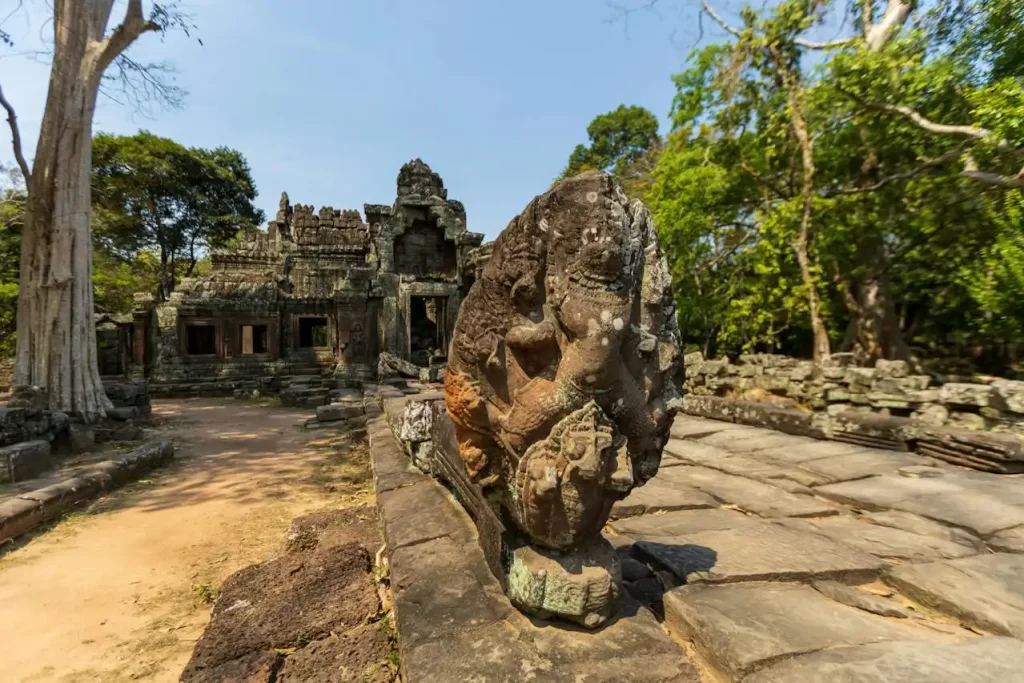Overview of Angkor Wat
Angkor Wat, nestled in the heart of Cambodia, is not just a testament to architectural prowess but a symbol of a rich, historical tapestry woven through centuries. This magnificent temple complex, originally built in the 12th century, stands as the largest religious monument in the world. It transcends its ancient Hindu and Buddhist roots to become a global icon of spiritual and cultural significance. In this detailed exploration, we delve into the architectural grandeur, historical significance, intricate artwork, spiritual and cultural importance, natural surroundings, and the enduring legacy of Angkor Wat.
Architectural Grandeur

Angkor Wat’s architectural magnificence is a marvel that has stood the test of time. Conceived by King Suryavarman II, this sprawling complex is a quintessential example of classical Khmer architecture. Its design is a harmonious blend of symmetry, intricacy, and grandiosity. At the heart of Angkor Wat lies the central temple, an imposing structure surrounded by a vast moat, signifying the mythical oceans surrounding Mount Meru, the home of the gods in Hindu cosmology.
The temple’s layout is a geometric marvel, featuring a series of concentric galleries, each one a maze of columns, pavilions, and courtyards leading to the central sanctuary. The ascending series of towers at the center symbolizes the mountain peaks. The architectural sophistication extends to the temple’s resilience; despite centuries of weathering and historical upheavals, Angkor Wat has retained much of its original structure and charm.
Beyond its physical structure, the architectural narrative of Angkor Wat is a chronicle of the Khmer Empire’s zenith. The harmonious proportions and the balance between spatial composition and decorative elements reflect a high level of sophistication in design and engineering, unparalleled in the 12th century. This architectural splendor is not just a showcase of past glory but a continuous source of inspiration and learning for modern architects and historians.
Historical Significance

Angkor Wat stands as a majestic reminder of the powerful Khmer Empire, which ruled much of Southeast Asia from the 9th to the 15th centuries. Its construction in the early 12th century marks a significant epoch in Cambodian history, when the empire was at its zenith. King Suryavarman II, its builder, envisioned it as both a state temple and a personal mausoleum, signifying the fusion of political and spiritual authority.
The temple’s transition from a Hindu center dedicated to Vishnu to a Buddhist site reflects the region’s religious evolution and the fluid nature of religious practices in Southeast Asia. This shift is not merely a change in religious affiliation but also a testament to the temple’s ability to adapt and endure through changing times and rulers.
Angkor Wat’s historical narrative is intricately linked with the rise and fall of the Khmer Empire. Its construction required an enormous allocation of resources, including labor, materials, and administrative effort, illustrating the empire’s capability and organizational skills. The temple also survived the eventual decline of the Khmer Empire and the shift of the capital to Phnom Penh, maintaining its significance through the centuries.
In contemporary times, Angkor Wat has become a symbol of Cambodian national pride and identity. Its depiction on the national flag is a rare honor, highlighting its importance not just as a historical monument but as an enduring emblem of the nation’s heritage and resilience. The temple’s history, therefore, is not only a chapter in Cambodia’s past but also a continuing story of its present and future.
Intricate Artwork and Carvings
The walls of Angkor Wat are a canvas narrating stories through exquisite bas-reliefs and sculptures. These artworks are not mere decorations; they are a visual scripture telling tales of gods, kings, and the cosmos. The level of detail in these carvings is astounding, with each scene meticulously crafted to capture the essence of the narratives.
The bas-reliefs depict a range of themes from Hindu mythology, including the famous “Churning of the Ocean of Milk,” a pivotal scene in Hindu cosmology. These artworks are more than just religious expressions; they are a window into the Khmer Empire’s culture, beliefs, and practices. The portrayal of celestial dancers, known as Apsaras, in various forms and postures, is a testament to the importance of dance and music in Khmer culture.
Equally fascinating are the depictions of historical events and scenes from daily life, offering insights into the social and cultural milieu of the time. These scenes include royal processions, battles, and everyday activities, providing a comprehensive view of life in the Khmer Empire.
The artistry of Angkor Wat extends beyond the visual to the symbolic. The alignment of the temple with celestial bodies and the representation of mythological themes reflect a deep understanding of astronomy and religious symbolism. This amalgamation of art, religion, and science speaks volumes about the sophistication and knowledge of the Khmer people.
In modern times, these carvings continue to inspire artists and scholars. Their preservation and study offer valuable lessons in art history and conservation, making Angkor Wat a living classroom for those interested in ancient art and culture.
Spiritual and Cultural Importance
Angkor Wat’s significance transcends its physical structure, deeply embedded in the spiritual and cultural fabric of Cambodia. Initially dedicated to the Hindu god Vishnu, the temple gradually became a Buddhist site, mirroring the region’s religious evolution. This transition from Hinduism to Buddhism is not just a change in deity worship but a reflection of the dynamic and inclusive nature of Southeast Asian spirituality.
For Buddhists, Angkor Wat is a revered pilgrimage site. The temple’s serene ambience, coupled with its religious significance, offers a spiritual experience that is both profound and personal. Pilgrims and visitors alike find in its corridors and galleries a space for contemplation and connection with the divine.
The cultural impact of Angkor Wat extends beyond its religious role. It is a symbol of the artistic and architectural achievements of the Khmer civilization. Festivals, rituals, and traditional performances held in and around the temple complex keep alive the customs and traditions of Cambodia.
Angkor Wat’s influence is also evident in contemporary Cambodian society. It plays a crucial role in the national psyche, embodying the resilience and endurance of the Cambodian spirit. The temple’s image on the national flag and currency is a daily reminder of the country’s glorious past and a source of national pride.
The temple complex, therefore, is not just a monument of historical and architectural significance but a living entity that continues to shape and reflect the spiritual and cultural identity of Cambodia.
Natural Surroundings
The natural setting of Angkor Wat is as integral to its appeal as its architectural and historical attributes. Nestled within a lush jungle, the temple complex offers a striking contrast between the structured grandeur of human creation and the untamed beauty of nature.
The moat surrounding the temple mirrors the natural water bodies in the region, playing a crucial role in the temple’s design and function. This integration of architecture with the natural landscape is a testament to the Khmer Empire’s understanding and respect for their environment.
The jungle surrounding Angkor Wat is not just a backdrop but an active participant in the temple’s story. Over the centuries, as the temple was abandoned and rediscovered, nature reclaimed parts of the complex, with trees and vegetation intertwining with the stone structures. This interplay between nature and architecture is a poignant reminder of the transient nature of human endeavors and the enduring power of nature.
Today, the conservation of Angkor Wat also involves the preservation of its natural surroundings. Efforts to maintain the temple’s structural integrity are complemented by initiatives to protect the local flora and fauna, making it a holistic conservation project.
For visitors, the natural surroundings offer a tranquil and refreshing escape. The sounds of the jungle, the play of light through the trees, and the sight of ancient stones against green foliage create an experience that is both awe-inspiring and grounding.
Enduring Legacy
Angkor Wat’s legacy is multifaceted, encompassing its historical, cultural, architectural, and spiritual significance. As a UNESCO World Heritage site, it is recognized globally for its outstanding universal value. This designation not only acknowledges its past importance but also ensures its preservation for future generations.
The temple’s enduring appeal lies in its ability to fascinate and inspire. It attracts millions of tourists, scholars, and pilgrims from around the world, drawn to its beauty, history, and spiritual aura. This continuous influx of visitors plays a crucial role in Cambodia’s economy, making tourism a vital component of national development.
The study and preservation of Angkor Wat also contribute to our understanding of ancient civilizations. Archaeologists, historians, and conservationists work tirelessly to uncover its secrets, ensuring that the temple’s story is told and retold.
Moreover, Angkor Wat’s legacy is not confined to its physical presence. It is a cultural icon, featured in films, literature, and art, influencing perceptions and imaginations globally. Its image on the Cambodian flag underscores its role as a national symbol, embodying the resilience and pride of the Cambodian people.
In sum, the legacy of Angkor Wat is a tapestry woven through time, capturing the essence of human creativity, spiritual aspiration, and the quest for understanding our past.
FAQs
- When was Angkor Wat built and by whom? Angkor Wat was built in the early 12th century by King Suryavarman II.
- Why was Angkor Wat built? It was originally constructed as a Hindu temple dedicated to Vishnu and later became a Buddhist site.
- What is unique about Angkor Wat’s architecture? Its architectural design is a masterpiece of symmetry and intricacy, representing classical Khmer architecture.
- Can visitors explore the entire temple complex? Yes, visitors can explore most areas of Angkor Wat, although some sections may be restricted for conservation purposes.
- Is Angkor Wat a UNESCO World Heritage site? Yes, Angkor Wat was designated a UNESCO World Heritage site in 1992, recognizing its outstanding universal value.
- What should visitors expect in terms of local customs and etiquette at Angkor Wat? Visitors should dress modestly, covering shoulders and knees, as Angkor Wat is a revered religious site. Respectful behavior and adherence to signage and guidelines are also expected.
- How has Angkor Wat influenced Cambodian culture? Angkor Wat is a symbol of national pride and is central to Cambodian identity. It influences art, literature, and even everyday life, appearing on the national flag and currency.
- Can Angkor Wat be accessed throughout the year? Yes, Angkor Wat is open to visitors throughout the year. However, access to certain areas may vary depending on conservation work and weather conditions.
- What conservation efforts are in place for Angkor Wat? Conservation efforts at Angkor Wat are extensive, involving local and international teams. These efforts focus on structural restoration, preservation of carvings and bas-reliefs, and environmental protection.










